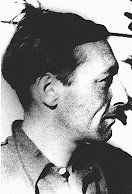
Franz Monjau
Born: January 30, 1903
Cologne, Germany
After secondary school, Franz studied painting at Duesseldorf's Academy of Fine Arts, eventually shifting to art education. He joined an avant-garde group rebelling against traditional painting. Later, he taught art to high school students. For Franz the drift towards fascism was frightening, as was the increasing antisemitism. But being only half Jewish, he did not feel worried about his personal safety.
1933-39: Hitler became chancellor of Germany on Franz's thirtieth birthday. Five months later Franz was arrested. By Nazi law he was classified as "Mischlinge" (mixed race) and banned from painting, exhibiting or teaching. His wife was barred from teaching because she was "intermarried with a non-Aryan." A museum director employed Franz secretly, but the Gestapo found out; Franz was fired. The Nazis assigned him to factory work after the war began.
1940-44: Franz and his wife managed to help the anti-Nazi underground. But then his wife was ordered to Berlin to work in a military hospital. In 1943 Allied bombing destroyed the Monjaus' home and nearly all of Franz's artwork. Then his mother, a Jew converted to Catholicism, was deported to the Theresienstadt ghetto. The bombings continued. Franz went into hiding when the Nazis began deporting "Mischlinge." He was denounced in fall 1944, interned at a "work education camp," and then deported to the Buchenwald concentration camp.
Franz died in Buchenwald's medical experiment barracks on February 28, 1945. The last note to his wife, smuggled out of the camp, read, "I am in Buchenwald. All the best. Franz."

